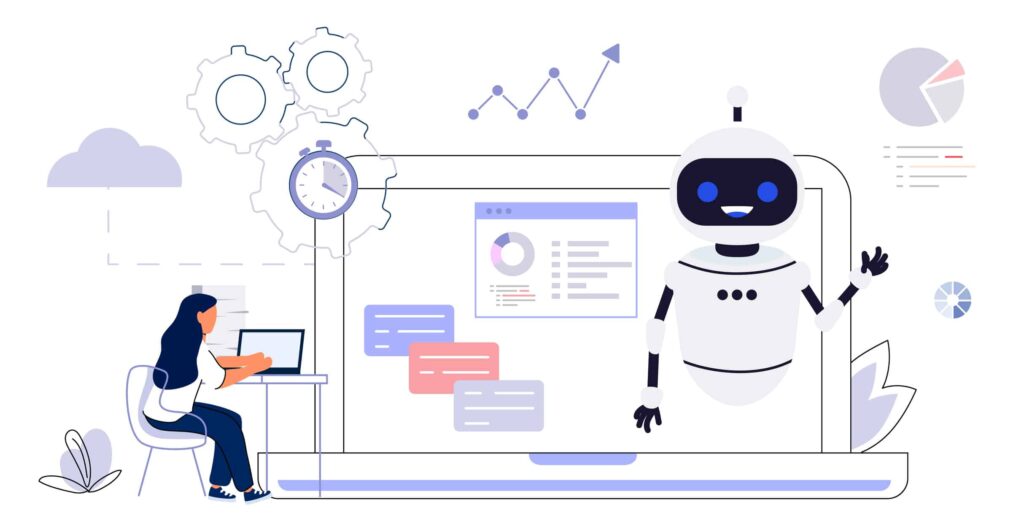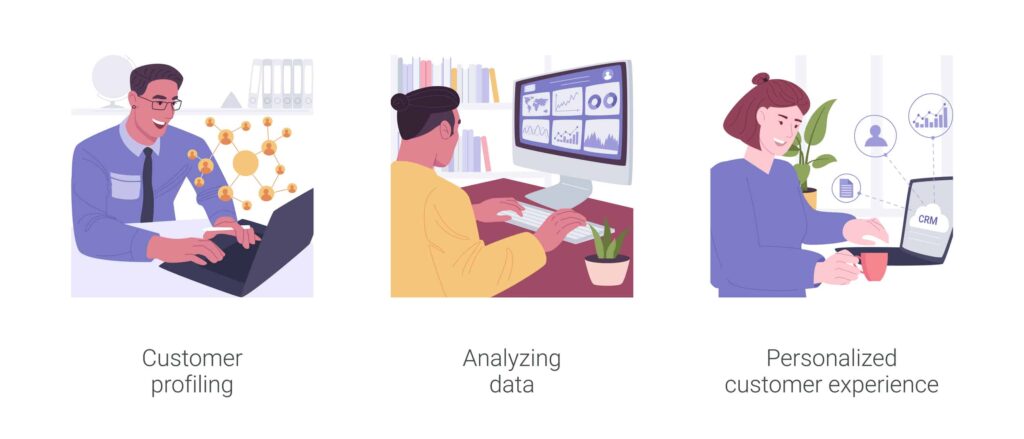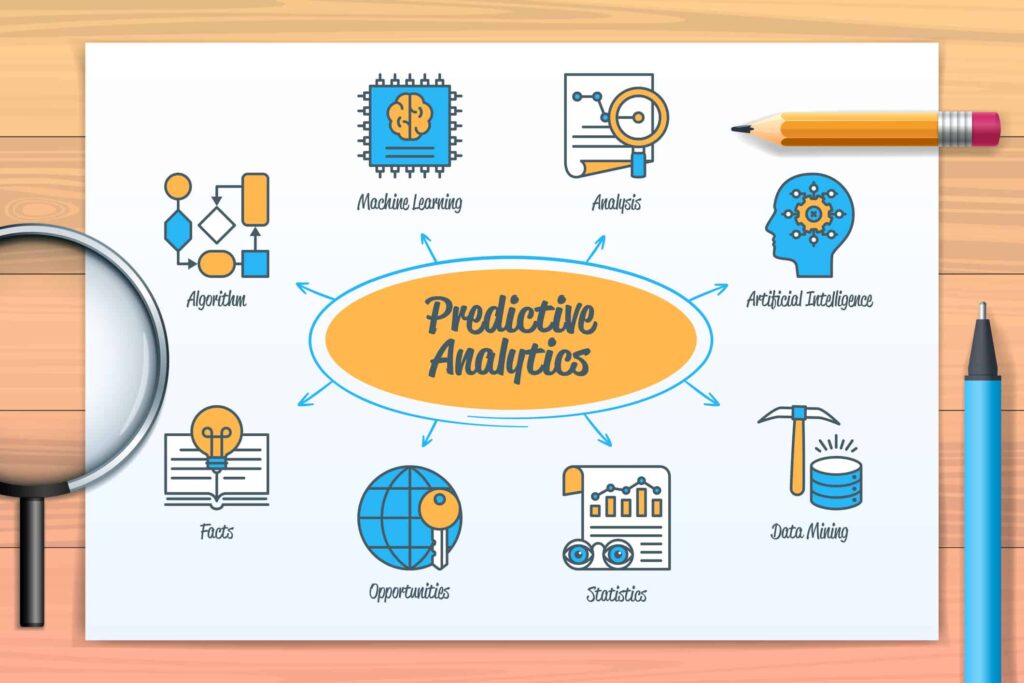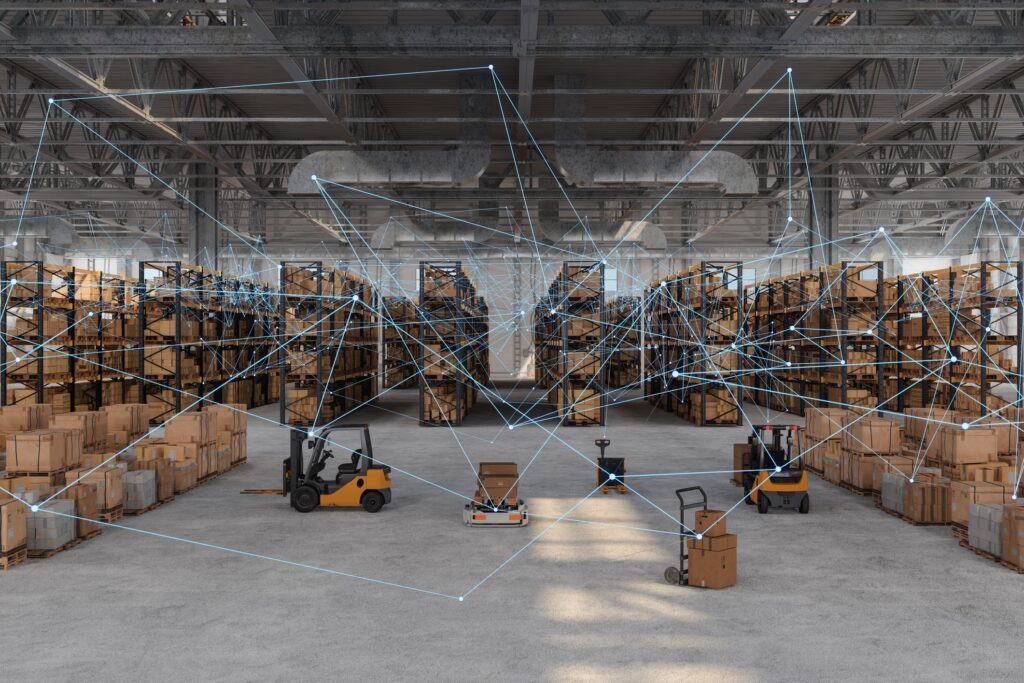
In recent times, the business landscape has undergone significant changes thanks to the introduction of Artificial Intelligence (AI) in business and its amazing features that are very helpful. We have seen the computers evolve from room-sized 1st Generation ones to the pocket-sized 5th Generation. Each Generation has boosted the potential of application in the Business world. It may be because of its usability in minting that we are still researching more and more in Computer Science and its sister branches.
Now, the focus has shifted to Artificial Intelligence (AI) and Data Science. The immense potential in Businesses is one of the driving forces that is keeping the hype going. People and corporations are taking more interest in the application of AI in business than ever before. Everyone has an eye on how it functions and yields helpful results in businesses gaining market insights and making corresponding moves.
There is plenty of data available. AI can effectively use this data, analyze it, and guide businesses in decision-making and operations via natural language processing technology. It has enormous potential in Making Marketing decisions, managing customer relationships, opinion mining, etc.
This blog will help you understand how AI influences businesses, assists decision-making, enhances customer experience, identifies the types of decision-making processes AI follows, and contributes to improving supply chains and logistics.
You can refer best AI marketing tools which will help you to select right AI tools based on your unique requirement to foster your business to growth
The Role of AI in Business Transformation:
Efficiency Optimization:

Artificial Intelligence contributes heavily to efficiency or process optimization. In an organization, many tasks are to be done repetitively every day. Many employees are stuck in these tasks and need more time to focus on other strategically important matters. This is where Artificial Intelligence can help in process optimization.
The term “AI process optimization” describes the application of artificial intelligence (AI) and Machine Learning technologies to enhance corporate strategies, accomplish objectives, and manage business processes. These include data analysis, task automation, and decision-making support for team members. Here, the main objectives are decreasing errors, increasing output, and boosting operational effectiveness.
Through end-to-end process automation and improvements, AI process optimization can increase return on investment. Additionally, it can assist companies in improving the precision and effectiveness of operations, including data entry, analysis, and decision-making. Artificial intelligence (AI) can help by making predictions based on patterns found in a particular data collection, which can support decision-makers in reaching impartial conclusions. AI optimization technologies are also useful for business expansion.
Example: Robotic Process Automation (RPA) in Finance
Many financial institutions have adopted AI-powered RPA to automate routine tasks such as data entry, invoice processing, and reconciliation. These companies use RPA to increase accuracy, decrease errors, and free up human resources for more strategic financial research and decision-making.
Cost Reduction:
Artificial Intelligence is changing how businesses work, no matter the industry. It’s making things digital, saving money, and reducing extra expenses. Here’s how Artificial Intelligence is helping companies cut costs:
Predictive Maintenance:
Factories spend a lot fixing machines. AI helps predict when a machine needs fixing. So, companies can repair it before it breaks, saving money and time.
Maximise ROI:
AI not only cuts costs but also helps make more money. A study found that 63% of businesses made more money using AI. AI is smart and finds ways to improve a business and earn more.
Limit Human Errors:
People make mistakes, and Mistakes cost money. But AI doesn’t make mistakes since it is trained with appropriate data. AI doesn’t forget and doesn’t make mistakes. By using AI, companies can reduce errors, save money, and work better.
Efficient Workflows, Less Cost, Better Quality:
AI makes work easier. It helps companies save on labor costs and do better work. AI can watch over work without needing a lot of people. It makes sure everything happens the right way. AI also stops repetitive task mistakes, improving work and saving money. Companies are using AI more because it’s becoming affordable, saving money in the long run.
Example: Predictive Maintenance in Manufacturing
Unplanned downtime and maintenance expenditures are frequent in manufacturing plants. By analyzing equipment data, AI-based predictive maintenance forecasts when machinery is likely to fail. Businesses can minimize interruptions in production and drastically cut maintenance expenses by addressing faults before they become serious.
AI-Powered Customer Experiences:
Personalized Marketing:

Personalized marketing refers to a marketing method where we target selective consumers and send them offers, recommendations, messages, etc. These personalized offers, messages, and recommendations are designed to cater to the targeted consumers’ interests.
Such personalized Marketing can be effectively done using Artificial Intelligence. Instead of using a one-size-fits-all strategy, it combines consumer insights with building a personalized experience that speaks directly to each customer.
AI technology gives machines human-like abilities to reason, learn, and make decisions. It involves instructing algorithms to see trends and formulate predictions using vast datasets. Artificial Intelligence (AI) has the potential to analyze large volumes of client data and generate tailored experiences on a large scale in personalized marketing.
For more understanding on use cases of AI in Marketinf you can refer How to Use AI in Marketing
Example: Netflix Recommendation Engine
Netflix utilizes a sophisticated recommendation engine that employs machine learning algorithms to analyze user viewing habits. By understanding individual preferences, Netflix recommends content tailored to each user, enhancing the overall user experience and keeping customers engaged.
Chatbots and Virtual Assistants:

It is very common to spot a chatbot on any website we visit. AI chatbot is a software program that uses machine learning and natural language processing to interact with people. AI Chatbots are designed to understand and answer user inquiries via text, simulating human conversation.
Conversely, the uses of AI virtual assistants are increasingly complex and are capable of managing activities and inquiries that are more complicated.
Benefits of using AI Chatbots and Virtual Assistants.
- 24-hour customer support: It lowers the waiting period while improving client satisfaction.
- An inexpensive solution: It offers effective solutions for a small percentage of the price.
- Respond to a lot of requests concurrently: It reduces expenses for the company and increases efficiency.
- Automates basic procedures so that support staff can focus their time on more complicated problems.
- Gather and examine client information: It gives organizations insightful information about the preferences and behavior of their customers.
Example: IBM Watson Assistant
IBM Watson Assistant is an AI-powered virtual assistant used in various industries, including healthcare and banking. These chatbots handle customer queries, provide information, and guide users through processes. This improves customer satisfaction and allows businesses to handle a large volume of inquiries simultaneously.
Data-Driven Decision Making:
Predictive Analytics:

Businesses use predictive analytics to look for trends in this data to pinpoint possibilities and dangers. Predictive analytics is frequently linked to data science and big data.
- Improving Data Security: By using predictive analytics, companies can proactively deploy security measures and thwart any threats by identifying odd patterns or suspect behaviors.
- Enhancing Risk Management: Predictive analytics, for example, can identify possible loan default risks by analyzing consumer behavior in businesses like finance. Businesses can use this information to optimize their risk management methods, lower financial risks, and make well-informed decisions.
- Increasing Operational Efficiency: Companies can anticipate and avoid operational problems thanks to predictive analytics.
- Streamlining Supply Chain Management: Businesses can predict inventory demands, avoid stock outs, and speed the purchasing process by examining demand patterns.
- Encouraging Financial Planning: By offering accurate estimates of future trends and market situations, predictive analytics helps in financial planning.
- Getting a Competitive Edge: In the end, predictive analytics gives companies a competitive advantage. Businesses can keep ahead of industry trends, foresee obstacles, and seize opportunities using data-driven insights. Businesses can adjust to shifting environments because of this strategic foresight.
Example: Salesforce Einstein Analytics
Salesforce Einstein Analytics is an AI-powered tool that provides predictive insights for sales and marketing. By analyzing historical stats and customer interactions, businesses can predict future trends, identify potential opportunities, and make data-driven decisions to drive sales growth.
Business Intelligence:
Business intelligence (BI) consists of gathering, evaluating, and reporting data to obtain insights. These features are strengthened and supported by AI in BI. BI deals with large data volumes, and AI performs fastest when it has a wealth of statistics. They collaborate with each other quite well. AI in BI is concentrated on managing input sources and processes more quickly and precisely. AI tools, for example, can identify data preparation flaws and duplication.
AI is also very good at producing insights from large datasets that may be challenging for humans to find. Using AI in BI for real-time dashboards and reporting allows businesses to obtain current and timely insights without requiring continuous human oversight. The advantages of AI in BI differ according to how each company applies it.
In general, artificial intelligence (AI) in business intelligence (BI) facilitates real-time reporting, automates business processes, efficiently maintains massive datasets, and offers insights that would be difficult to obtain without AI. While collaborative efforts between humans and AI yield the best outcomes, increasingly intelligent AI systems can also be used to their advantage when operating more independently. Ultimately, artificial intelligence in business intelligence (BI) speeds up, streamlines, and can provide insightful information.
Example: Tableau's Explain Data Feature
Tableau, a popular BI tool, has integrated AI to help users understand the “why” behind their data. The Explain Data feature uses machine learning to analyze data points and provides explanations, making it easier for businesses to derive meaningful insights.
Artificial Intelligence in Supply Chain and Logistics:

Demand Forecasting:
AI in demand forecasting is like having a super-smart assistant that uses artificial intelligence (AI) to make predicting what you need even better. Instead of just looking at what people bought before, it looks at a whole bunch of things like what’s happening in the market right now, what people are saying on social media, and even online reviews. The numbers show that this AI superhero is making a significant impact.
- Data Preparation: AI tools can quickly fix mistakes, ensuring everything is accurate and ready to use. It’s like having a super helper that keeps everything tidy.
- Analytics: AI makes analyzing big piles of data much quicker. It looks at all the important numbers and turns them into helpful insights businesses can use.
- Insight Generation: AI can find patterns and connections in data that are hard for people to spot. It’s like having a detective to uncover secrets in your business.
- Real-time Reporting and Dashboards: AI helps create reports and dashboards that show what’s happening right now. This means businesses can make decisions quickly without waiting for someone to check all the data.
By mixing AI with smart planning, businesses can sail through the challenges of keeping their shelves stocked and customers happy.
Route Optimization:
- Enhancing efficiency in transportation and logistics: Artificial Intelligence makes a big difference in how companies plan routes and manage transportation. Let’s break down how it’s changing the game.
- Smart Route Choices: AI is like a super-smart navigator that picks the best routes in real-time. It adjusts on the go, making sure deliveries happen on time and everything runs smoothly. You can imagine the working of Google Maps here.
- Efficient Loading and Delivery: Think of AI as a puzzle master. It figures out the best way to load and deliver goods, saving time and resources. It’s like having a strategy to get everything where it needs to go in the smartest order.
- Taking Care of the Fleet: AI wears many hats when it comes to managing the fleet. It helps schedule maintenance and keeps an eye on how drivers are doing. This is crucial for ensuring everything runs efficiently and safely in the long run.
- Saving on Fuel, Repairs, and Wear and Tear: Imagine you’re planning a road trip, and you find the quickest route. That’s what route optimization does, but for delivery trucks. It figures out the shortest and most efficient paths, like avoiding traffic jams, which means less fuel is used. And when trucks travel fewer miles, they don’t wear out as quickly, so you save money on repairs and maintenance.
- Making the Most of Drivers and Vehicles: Have you ever employed someone and realized you could leverage it for more than you thought? That’s what happens when routes are optimized. It ensures delivery trucks and drivers are leveraged to their full potential. This efficiency cuts down on labor costs, making operations smoother and more cost-effective.
So, route optimization is like having a smart GPS for delivery trucks, helping them take the quickest and most efficient paths. It’s not just about getting things from point A to point B; it’s about doing it to keep costs down and operations running like a well-oiled machine.
Example: UPS ORION System
UPS employs the On-Road Integrated Optimization and Navigation (ORION) system, which uses AI algorithms to optimize delivery routes. By considering various factors such as traffic patterns and delivery constraints, UPS maximizes efficiency, reduces fuel consumption, and ultimately lowers operational costs.
Future Trends in AI for Business:
As we delve into the capabilities of Artificial Intelligence, it becomes evident that people are increasingly testing its boundaries to understand its potential. While caution is essential to avoid undue risks, the trend highlights a growing curiosity beyond tech hubs like Silicon Valley. This experimentation, however, emphasizes the importance of vigilant fact-checking, especially when relying on AI technology for tasks like legal research.
- Testing AI Boundaries: The cautionary tale of using AI for legal research underscores the necessity of fact-checking AI output. Despite the potential pitfalls, it signifies a broader trend of individuals and businesses testing AI’s capabilities. This hands-on approach allows users to identify areas for improvement, guiding developers to enhance the technology.
- Balancing Innovation with Risk Management: While embracing the uses of AI innovation, it’s crucial to strike a balance and not expose oneself or clients to unnecessary risks. Continuous monitoring of evolving laws, particularly in intellectual property and copyright domains, is essential. Adapting to industry regulations ensures a responsible integration of AI without compromising legal and ethical standards.
- Developing a Holistic Understanding of AI: As experimentation with AI technology progresses, a more nuanced understanding of its capabilities will likely emerge. Dispelling the notion of AI replacing humans, the evolving landscape suggests that while AI may assume certain tasks, it opens avenues for new human roles. These may involve supervising AI, creative collaboration, or directing AI efforts, indicating a symbiotic relationship between humans and AI.
- Creating Opportunities for Human-AI Collaboration: Current collaborative tools for AI and humans, such as Sudowrite’s Story Engine and Notion AI, showcase the potential for effective collaboration. While these tools enhance productivity by automating repetitive tasks, they appear daunting to newcomers. Organizations should appoint experts to guide employees through challenges to ease the transition.
- Advancements in Data Analytics: As businesses gain a better understanding of AI’s applications, data capture and analysis advancements are anticipated. AI’s role in analyzing workflow and consumer behavior through embedded systems promises a more comprehensive understanding of operations. Human-AI collaboration will likely extend to interpreting this new data, contributing to strategic decision-making.
- Fortifying Data Security with AI: AI’s role in enhancing security is poised to grow. Its ability to swiftly test network capabilities surpasses human capabilities, providing a proactive approach to identifying and addressing vulnerabilities. While AI offers robust security measures, human ingenuity will likely complement AI’s limitations in creative problem-solving.
- Content Creation Tailored for AI: Content creation strategies may evolve to anticipate AI tools’ reading and learning capabilities. Similar to SEO optimization, content creators may tailor their material to align with how AI tools interpret text and images. However, it is crucial to strike a balance, avoiding overemphasizing AI performance at the expense of engaging content for real human readers.
- Ethical Regulations for AI: The uses of AI technology has brought ethical concerns to the forefront, prompting the need for regulations. As our understanding of AI matures, expect ethical considerations to take center stage. Enacted regulations may focus on protecting creators’ work from unauthorized use in AI learning and guide businesses on ethical AI utilization.
- Bringing AI and Machine Learning into Business Strategy: Incorporating AI technology and Machine Learning into business strategies involves identifying areas for improved productivity, choosing user-friendly AI tools, staying informed about AI regulations, addressing ethical concerns, and exploring opportunities for testing new software. Regardless of the industry, AI’s utility demands thoughtful consideration and strategic integration.
Example: Quantum Computing in Drug Discovery
Enterprises like Google and IBM are investigating the application of quantum computing to resolve challenging issues. Quantum computing can potentially speed up drug discovery in the pharmaceutical sector by accurately simulating molecular interactions at a resolution impossible with conventional computers.
Conclusion:
AI has significantly contributed to business and will continue to do so as it develops. It is up to us to make effective use of it. The topics in the blog post make it clear that AI is helping businesses in many ways. It has a significant impact on sales and profits. The real-life examples of AI in each section of the blog put light on the application part of the theory or concept. AI has the infinite potential to spur innovation and change in the business sector as technology develops.
Frequently Asked Questions (FAQs)
Q1 Could AI eventually take over the world?
AI is entering every field and making things easier for everyone. It will surely be seen more, but it can replace humans completely.
Q2 Is it possible for artificial intelligence to be moral?
AI will reflect the ethics of the people who develop it.
Q3 AI is purely useful for big companies, or can smaller companies also profit from it?
AI is available to all sizes of enterprises. Numerous AI solutions, including chatbots, data analytics, and process automation, are scalable and adaptable to small enterprises’ demands and budgets.
Q4 How many predictive analytics benefits my company, and what does it include?
AI is used in predictive analytics to examine past data and forecast future patterns. This can assist businesses in demand forecasting, inventory optimization, and making well-informed decisions to keep ahead of market shifts.
Q5 Is it possible to lower operating costs with AI?
Indeed, through process optimization, maintenance demand prediction, and regular task automation, AI can help save operating expenses. Increased productivity and resource optimization result from this.

